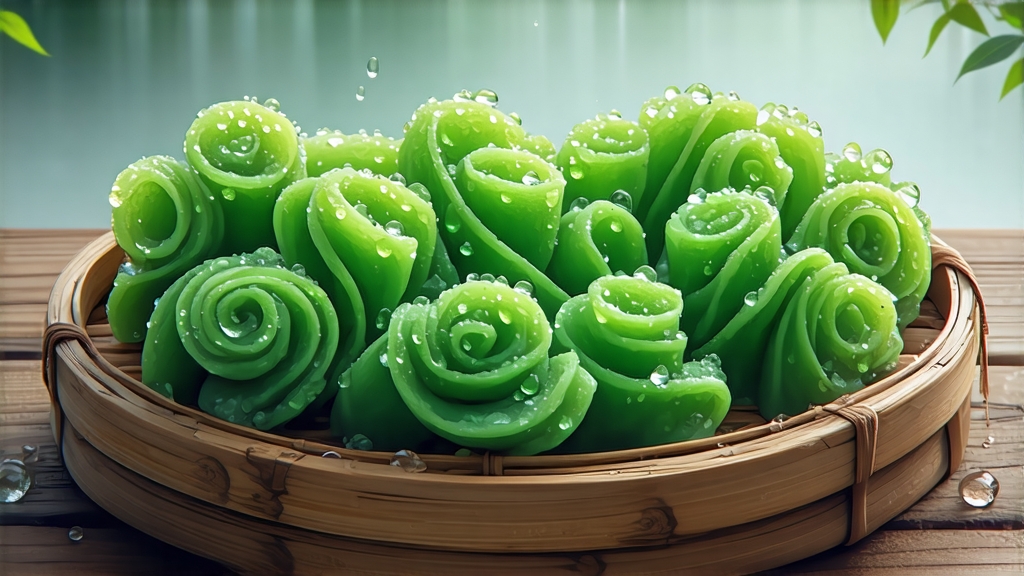
Biluochun, whose name translates literally to “Green Snail Spring,” is one of China’s ten most celebrated teas, yet it remains a quiet mystery outside specialist circles. Grown on the mist-laden, fruit-tree-capped hills that ring East China’s Taihu Lake, this emerald-green tea is prized for the tight spiral each bud forms, a shape said to resemble a tiny snail shell. Beyond its appearance, Biluochun offers a fragrance so unexpectedly floral that first-time drinkers often assume petals have been blended into the leaf. Nothing could be further from the truth: the aroma is the pure, unadulterated scent of the tea itself, coaxed into existence by one of the most delicate crafting sequences in all of green tea production.
Historical records place Biluochun’s rise to fame during the late Ming and early Qing dynasties. Local legend claims that a tea-picking girl fleeing bandits hid her half-filled basket under wild tea bushes blooming with apricot and plum blossoms. When she returned hours later, the buds had absorbed the orchard perfume, giving rise to the tea’s signature scent. Scholars dismiss the tale as folklore, yet they agree that the proximity of tea gardens to fruit trees is no accident: farmers discovered centuries ago that the shared pollinators and overlapping bloom cycles subtly influence tea chemistry. By the Kangxi Emperor’s reign (1661-1722), the court had already classified the tea as a gong cha, or “tribute tea,” shipped north to Beijing in spring caravans that raced against warming weather to keep the leaves fresh.
Strictly speaking, only leaf plucked within Dongting Mountain, an island in Taihu Lake, Jiangsu Province, qualifies as authentic Biluochun. Even here, micro-terroirs matter. The highest grade, Xiaoshan (literally “Small Mountain”), comes from slopes between 200–300 m where morning mist lingers longest, filtering sunlight and encouraging slow, amino-rich growth. Lower elevations produce Dahu (“Large Lake”) style, still fragrant but lighter in body. A third category, Wai Shan (“Outer Mountain”), refers to leaf grown on the surrounding mainland. These distinctions are not mere marketing; they mirror the French concept of cru, with Xiaoshan offering the most concentrated sweetness and the longest, most layered aftertaste.
Plucking begins when the tea bush awakens, usually two weeks after Qingming festival, when each shoot holds one barely unfurled leaf and a tight bud known as a sparrow’s tongue. Experienced pickers work in pairs, one nipping the shoot, the other catching it on a bamboo tray to prevent bruising. Speed is essential: the leaf must reach the village workshop within four hours before enzymatic oxidation edges the leaf away from its desired green profile.
The crafting of Biluochun is a ballet of heat, pressure, and timing spread across four stages: kill-green, primary rolling, secondary rolling, and final drying. Because the leaf is exceptionally tender—each kilo of finished tea needs roughly 70,000 buds—temperatures are kept lower than those used for heartier greens like Longjing. A traditional wok, pre-heated to 180 °C, receives a small batch of 250 g. The tea master’s bare hand flips the leaf for three minutes, relying on skin sensitivity to judge when the cells have been sufficiently ruptured to halt oxidation without scorching the surface. The wok is then cleared of surface heat, dropping to 70 °C, and the primary rolling begins: fingers press the leaf against the wok in clockwise circles, curling it into the iconic snail shape while evaporating moisture. After fifteen minutes the leaf is removed, allowed to rest for five, then returned for a second, gentler rolling that sets the curl and refines aroma. Finally, the tea is tumble-dried at 60 °C until moisture falls below 6 %. From plucking to finished product takes no more than four hours, a pace that preserves the orchard bouquet and locks in a jade-green color that resists dulling even after months of storage.
To unlock these carefully guarded flavors, water choice and temperature are critical. Filtered water with moderate mineral content (around 100 ppm TDS) accentuates sweetness, whereas very hard water flattens fragrance. Heat water to 75 °C; hotter temperatures extract catechins too quickly, resulting in astringency. Use a tall, thin glass or a 150 ml gaiwan; both allow the buds to stand vertically, a visual spectacle often called “the forest of spears.” For every 3 g of leaf, pour 120 ml